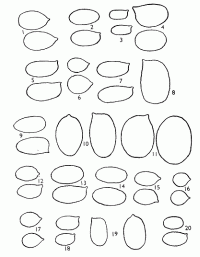|
 Cantharellus elsae Cantharellus elsae
SynonymsHygrophorus elsae
BiostatusPresent in region - Indigenous. Endemic
Images (click to enlarge)
Caption: Cantharellus elsae: i, basidia; j, spores |  | 
Caption: Spores X 2000 1. Hygrophorus salmonipes 2; H. elsae; 3, H .julietae; 4, H. variabilis; 5, H. lilaceo-lamelllatus; 6, H. muritaiensis; 7, H. keithgeorgei; 8, H. pseudococcineus; 9, H. rubro-carnosus; 10, H. miniceps; 11, H. procerus; 12, H. multic |
Article: McNabb, R.F.R. (1971). Some new and revised taxa of New Zealand Basidiomycetes (Fungi). New Zealand Journal of Botany 9(2): 355-370 (http://www.rsnz.org/publish/abstracts.php).
Description: Pileus 3-4 cm diam., hemispherical or joined in irregular spathulate groups, dry, matte or subfibrillose, pallid salmon. Cuticle a cutis, composed of repent, slightly interwoven, thin-walled, septate hyphae 4-6 µm diam., terminal cells unspecialised, clamp connections absent. Lamellae deeply decurrent, distant, thick, irregularly forked, salmon, running into shallow grooves on the stipe. Stipe 2-3 cm long, 0.5-1 cm diam., or fused in irregular groups, dry, matte, velvety, concolorous with pileus. Cuticle a palisade of thin-walled, subclavate cells 50-75 X 7-10 µm, of hymenial origin as indicated by occasional functional basidia.
Spores ovate-elliptical or ovate, hyaline, inamyloid, apiculate, 7.5-10.5 x 4.5-6 µm, thin-walled, smooth. Hymenium continuous; basidia hyaline, long, cylindrical to subclavate, often with yellowish contents, 74-144 x 7.5-10.5 µm, 4-spored, sterigmata to 8 µm long: cystidia absent. Hymenophoral trama without organisation composed of thin-walled, hyaline, septate hyphae 4-6 µm diam.; clamp connections absent. Context of pileus pinkish, rather brittle.
Habitat: Gregarious or caespitose under native trees.
Distribution: TYPE LOCALITY: Lake Rotoiti, Nelson, New Zealand.
Notes: The above description is adapted from that of Stevenson with the addition of certain microscopical characters. The type specimen, which was jointly examined with Dr E. Horak, is in fragmentary condition, but the extremely long basidia and lack of organisation of the hymenophoral trama indicate that this species belongs in the Cantharellaceae rather than Hygrophoraceae.
Cantharellus elsae can be accommodated in subgenus Cantharellus sect. Cantharellus as defined by Corner (1966) although the absence of clamp connections is not typical of this section.
Article: Horak, E. (1971). A contribution towards the revision of the Agaricales (Fungi) from New Zealand. New Zealand Journal of Botany 9(3): 403-462 (http://www.rsnz.org/publish/abstracts.php).
Notes: Hygrophorus elsae Stevenson (28 D) = Cantharellus elsae (Stevenson) comb.
nov. (Basionym: H. elsae Stevenson, Kew Bull. 16: 375, 1962)
A redescription of this species will be published by McNabb in the near future.
Article: Horak, E. (1990). Monograph of the New Zealand Hygrophoraceae (Agaricales). New Zealand Journal of Botany 28(3): 255-306 (http://www.rsnz.org/publish/abstracts.php).
Notes: H. elsae Stevenson, Kew Bull. 16: 375 (1962) = Cantharellus
elsae (Stev.) Horak, N.Z.Journ Bot.9: 420 (1971).
Article: Stevenson, G. (1963) [1962]. The Agaricales of New Zealand: IV. Kew Bulletin 16(3): 373–384.
Description: Pileus 3-4 cm. Diam., pale salmon, hemispherical or
joined in irregular spathulate groups, matt or subfibrillose; flesh pinkish,
somewhat brittle. Gills deeply decurrent, salmon, thick, distant, irregularly
forking, running into shallow grooves on the stipe. Stipe 2-3 X 0.5-1 cm., or
in irregular fused clumps, concolorous, matt, velvety. Spores 5.5-6
X 9-9.5 µm., ovoid, hyaline, Basidia
60-70 X 8 µm., four-spored.
Habitat: habitat: in litter under Nothofagus,
Lake Rotoiti, Nelson, 21.4.19541 Stevenson, & E. Kidson. 16.5,1956.
|